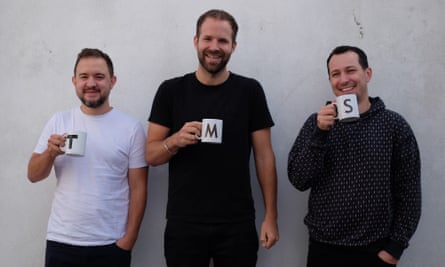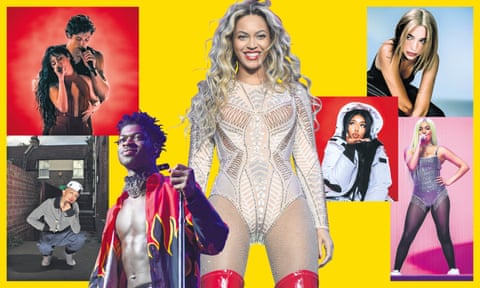Landing a No 1 single was a little different at the beginning of the 2010s than it is now. The songwriting and production team TMS – who have achieved both – fondly remember the limousine that was sent to pick them up from one of their mums’ houses and whisk them off to a West End party when they scored their first No 1 single with N Dubz rapper Dappy’s No Regrets in 2011. These days, there is less glamour. “It’s more like resetting the clock,” says Ben Kohn, laughing. “It’s kind of like you bought yourself another couple of years to not get a proper job.”
Kohn, Tom Barnes and Peter Kelleher have been writing songs together since they were childhood friends, starting in a garden shed. Today, sitting down to chat in their Richmond studio, they speak excitedly over each other’s sentences as they discuss their latest chart topper, the anguished Lewis Capaldi ballad Someone You Loved.
Getting to the top of the charts with Lewis in 2019, says Kelleher, was like “a shot in the arm”, as it had been four years since their last No 1 (Jess Glynne’s Don’t Be So Hard on Yourself). Barnes says that the rapid churn of the charts during the pre-streaming age made it much easier to take a new song to the top: “Back then, you’d probably get between 45 and 50 No 1s a year, whereas now you get 10.”
“Around the Dappy time, you had pre-sales,” adds Kelleher. “Then you were fired up [the charts] in week one.”
This decade of pop music has arguably seen more rapid change than any before it. The insatiable appetites of the digital age and the sheer quantity of music that fills out Spotify’s weekly New Music Friday playlist make it harder than ever to cut through the noise. So what is it like to be a professional hitmaker in such an unstable and competitive time? For Camille Purcell, who releases music as Kamille and writes for Little Mix, Clean Bandit and Mabel, these days it’s all about interesting beats, not hooks. “Five years ago, you had to have a massive chorus,” she says. “Now, it’s not the rule.” She cites the dominance of hip-hop as the cause of this trend towards more muted pop songs, because “those choruses are so simple, there’s nothing to them. The production is so minimal.”
Kamille says she often takes inspiration from the “viral-led language” of social media posts and memes and that pop lyrics are becoming “so much more real and to the point – super conversational”. TMS’s Kohn agrees: “There was definitely a period when people were writing songs that were like Titanium,” he says, describing Sia’s heavily metaphorical tale of personal resilience as a “big themed song. Whereas now, I feel like the thing artists say a lot of the time is: ‘It’s got to sound like I’d actually say it.’”

Major pop songs are also tackling different subjects than they did in the past, with mental health, politics and the idea of female empowerment all becoming common subjects of discussion in the writers’ room. MNEK, who, in addition to his own music, has writing credits for Beyoncé, Dua Lipa and Little Mix, believes it is important to tweak songs so that they become personal for the artist singing them. When his track IDGAF was picked up by Dua Lipa, for example, she went in the studio with him to rewrite the lyrics and make them more relevant for her. He also worked on OK (Anxiety Anthem) for Mabel’s 2019 debut album. “I was very proud that she was able to open up to me. That really strengthened our friendship,” he says. He compares writing sessions to therapy. “You build relationships with these artists.”
Ali Tamposi – a Los Angeles-based writer who worked on Camila Cabello and Shawn Mendes’s Señorita – says this shift in subject matter reflects wider societal change. “The language is changing,” she says. “There’s been a huge surge in female empowerment. And I definitely feel that men are being way more vulnerable in the things they’re talking about. Artists are willing to talk about their weaknesses.”
While the scope of pop’s themes has expanded, the time in which artists have to air them has shrunk: breaking through is no longer so much about making it on to a radio playlist as it is about the catching a listener’s ear before they hit skip – which, on Spotify, happens to a quarter of songs in the first five seconds.
“I love 90s and 00s R&B, and those songs go on for ever,” says MNEK. “Songs these days don’t have that patience. We have so much access to everything now, it’s like, why would you wait a minute for a song to kick in?”
TMS say they try not to think too much about skip rates when they are writing, but Kelleher notes: “In every era, there will be shortcuts that will help make a seven out of 10 into a hit, whether it’s beat pattern, drum sounds, ways of structuring songs. Songs on the top tier will succeed on their own merits, but there are definitely tips and tricks [for the others].”
Some of those tricks include keeping on top of ever-changing trends – Kamille says she frequently begins her sessions by listening to playlists of current hits, taking stock of the musical landscape. She is also obsessed with TikTok, the video app that lets users lip-sync, which she says is teaching her about the “entertainment value of a song” – in other words, which bits of a hit can be turned into a meme: “I think about [adding] weird production parts, because that tends to really work on TikTok.”

“In many respects, what people are looking for now is the weirdest stuff,” Kohn says. There’s no longer as much of a formula to scoring a mainstream pop hit as there might have been 10 years ago – and comparing the artists who went to No 1 this year shows a massive disparity in styles, from Lewis Capaldi to Lil Nas X to Billie Eilish. “Eilish is a brilliant example,” says Kohn. “If something just sounds like completely straight pop, its sound doesn’t go anywhere. In a way, there’s more pressure to be experimental.” Tamposi notes that a lot of the biggest hits of recent years have been a result of the internet age’s tendency to cross-pollinate genres. “Mixing urban with country, Latin with pop – people are taking more sonic risks. There’s no rules,” she says. That might make it harder to predict what will be a No 1 hit, but that’s the fun of it. “It makes creating so much more exciting, because we’re not trying to fit in this perfect pop box.”
“That’s the interesting thing about pop music – the good pop music isn’t trying too hard to be pop music,” says Kohn. “The natural inclination when you start to write pop is almost to be a bit too cheesy. When we realised we could pour in all our hip-hop and breaks influences – that was when people started going: ‘This is pretty fun.’”
The days of limousines calling at their mums’ houses may be over, but the joy of crafting a smash hit clearly isn’t.
